In Roman mythology, Rome was founded on the death of Remus, after a heated dispute with his twin-brother Romulus on where to lay the foundations of the ancient city. This myth serves a backdrop for the city and its people, not for the tale’s violent or aggressive elements – but for the display of will and determination that came after Remus’ death; a survival and enduring trait embodied by Romans throughout.
Located in the Mediterranian belt, Italy is generally predisposed to the sun and mild winters. Rome is no exception; snowfall being a rare sight, and a combination of both low temperatures and the sun being a Winter staple.
But lest I romanticise, we started our exploration of Rome predictably in a walk towards the Colosseum. The trail which gave me a taste of what to expect from both Roman architecture and its people.
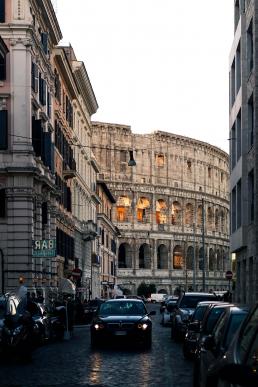
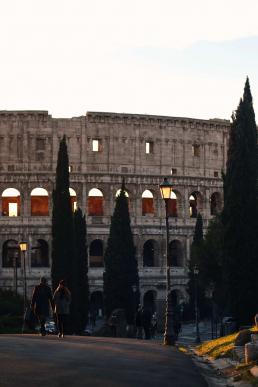
When one speaks of Rome, the Colosseum is the iconic landmark that springs to mind. It is the setting for acclaimed films – my personal favourite being Ridley Scott’s Gladiator that exemplified the ferocity of ancient Roman social life and the spectacle that ensued every time slaves, prisoners of war or warriors enter the arena for the entertainment of Roman society. The Colosseum was larger than I imagined it. Built during 80 AD, it could occupy up to 80,000 on a good day and was a magnificent artefact.
The Colosseum now stands in partial ruin, broken columns echoing the roar of crowds and smoothened slopes alluding to where seats used to be. Once upon an era, thousands would have spent hours here witnessing bloody combat or elaborate animal hunts. Though those were historically rare, and only held on the occasion. The morning sun shone on the stones, painting the ancient structure in fiery-orange. In its most glorious days, which the Roman empire had seen plenty – the Colosseum would have been a grand sight and permanent symbol of the empire’s lasting power. At least, until the Roman Empire devolved in 476 AD and ushered in the Middle Ages; transforming Rome into the seat of Catholic Christianity.
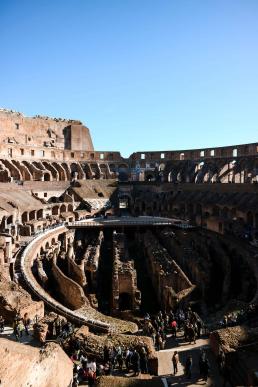

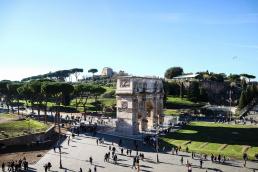
As a city, Rome has witnessed the transformation of its people and landscape for centuries. It was the seat of an empire that spanned leagues, evolved from a monarchy into a republic and gave birth to intellectuals and Stoic philosophers such as Cicero, Seneca and famously Emperor Marcus Aurelius – who compiled his most private stoic meditations into a text that’s now become a guide for modern-day Stoics. In its soul, Rome and its nation had evolved, shaped and influenced the world over. Rome gave birth to Catholic Christianity, evident with the Vatican in the heart of the sprawling metropolis. Despite modernity that streams through the city’s streets in forms of consumer culture, churches are aplenty, and the cross is seen around many a street corner and the private indoors of Romans.
The architectural narrative of Rome shifts in contours as one walks through its countless roads, streets and alleyways. The Renaissance, the spiritual, intellectual, social and artistic peak of Western civilization has its roots in Rome. Evidence of the Enlightenment visible throughout the public squares, fountains, statues, frescos and palazzos. The city flares into glorious golden during both sunrise and sunset when the brick walls and roofs shine in shades of amber. Rome’s architectural palette shades safely in pastel, the colours salmon, yellow, brown and orange decay being of most popular choices. For this, every building in Rome is in danger of looking uniformly similar but hides within each and every one of these private palazzos a variance of stories.
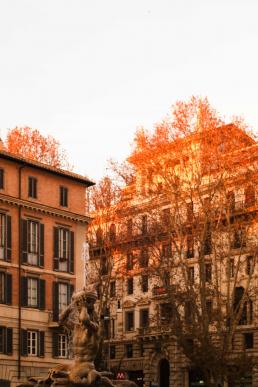

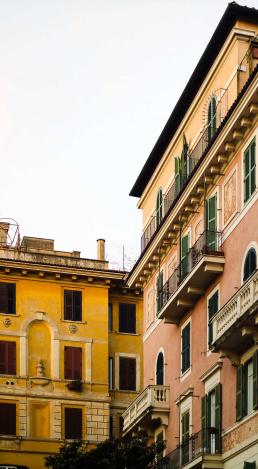
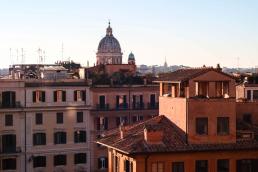
On one of the days in the city, I got scammed. I had unwittingly entered a taxi with my wife and sister and foolishly forgot to: (1) check my destination’s map beforehand, and (2) request for the meter. The taxi driver slyly drove me around a few blocks for a good ten minutes and dropped me off on the opposite end of the main building – taking €20 for what was, in reality, a €5 ride at most. It was an experience that also elucidated to me the state of the nation’s economy and the pride its people suffered since the end of World War 2 and the recent global economic crisis.
Migration and a borderless economic bloc had not been kind to the nation. Following the 2008 economic crisis, Italians at large have difficulty finding jobs, the country is in massive debt, and there is a financial hunger – as well as political apathy towards what is believed to be a corrupt and inefficient system. And like many nations across the world, there is inequality among those in the rural South and the modern North. Could one blame scams to occur in an environment where every man is for himself, and it is a ‘scam or be scammed’ situation? This is not an apology for an unethical act but is instead a call to understand the Roman material condition.
There is a great pride to be held in a rich history whose canvas contains the seeds of Western Enlightenment, the leagues of an ancient empire, the birthplace of philosophers and the pride of artisanal culinary. Despite this, the Romans regardless have the will and strength to persevere despite modern social, political and economic obstacles. And for a country whose strength is derived in its past, the past is one thing Rome is not short of – as the iconic Trevi Fountain and Pantheon exemplify among hundreds of other ancient artefacts.


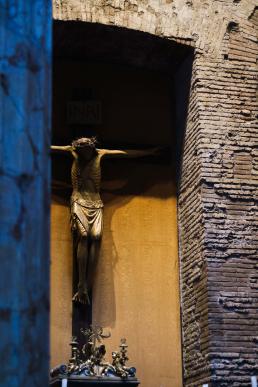
Rome is also backdropped in cinema, with Dan Brown’s thriller Angels and Demons seeing its lead protagonist cross over the metropolis’ different sites to solve ancient clues embedded in historical symbolism. Or the romantic comedy Only You where Robert Downey Jr., at one point of his career, banked on his boyish-youthful looks to swoon a young Marisa Tomei in the iconic Bocca della Verità, the Roman Mouth of Truth. Most famously, Roman Holiday that saw Audrey Hepburn tour around the ancient city. So iconic is the film that in a few small restaurants we stopped in for lunches, we would spot a frame still from the film; Audrey Hepburn in radiant beauty, grinning in joy as she rides a Vespa across Rome’s cobblestone streets with Gregory Peck worryingly looking over her shoulder.
Rome, it seems, captures the imagination of those from the outside. Promises of espresso, pasta, pizza and straying into a quiet palazzo. But for all its cultural imagery, the metropolis also bears the fruit of spirituality and religion. Situated in Rome’s core is Vatican City, the beating heart of Catholic Christianity; its influence flowing through the veins of Rome – outwards and permeating through everyday Roman life. The independent city-state does not have any borders that separate it from the outer secular world.
It was Christmas Eve, and St. Peter’s Basilica Square was reasonably occupied. Later tonight and the next morning, the square will be full of pilgrims and the faithful – listening to the Pope’s address and contemplating their place in the broader thread of humanity. This Christmas, Pope Francis would preach the bridging of humanity, and the acceptance of migrants. A timely issue for trying times. As one walks throughout the square, it is hard to ignore the subject of the Pope’s speech: gipsies and old women, hunched almost double and draped in black seeking donations, and South Asian migrants selling counterfeit souvenirs to make a living.
Migrants are especially common throughout the metropolis. Mostly South Asians and Africans who have escaped their homeland for a better life overseas; drawn in by the promises of a financially-rewarding pilgrimage to the ancient city. Everywhere throughout, especially in tourist traps – I spent many afternoons observing migrants unsuccessfully approach tourists, hoping to make a sale. They are treated with suspicion and are either avoided, ignored or protested against. Some, in order to meet the bottom line, resort to pressure salesmanship, placing the items on an unsuspecting tourist’s hand and then claiming a charge for it. Very often, the item is forcibly returned when the person realised the gravity of the situation, walking away with a slightly bitter experience of Rome.
But underneath this unpleasant social veneer is a deeper systemic problem of exploitation by the mafia, rampant racism, as well as a disregard for basic humanity. The migrant question is a perennial one shared throughout the globe, but in Rome – it has reached its peak with far-right Romans rejecting migrants on reasons of social tension.
They are not welcomed, but they have nowhere else to go. God help the outcasts, indeed.

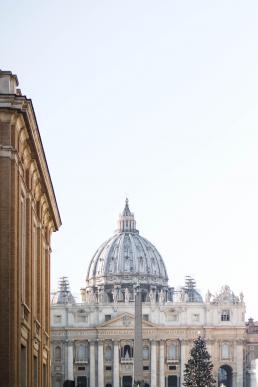
It was half past three in the afternoon, and the sun was blazing above our heads. As one walks throughout Rome, the one unmissable feature is the cafe and restaurant. While the Italian culinary institution had most certainly begun from a mother’s kitchen – the eatery is where it is laid to a practical test.
Thanks to popular media and the global proliferation of Italian cuisine, the world is well acquainted with the likes of pasta varieties and Neapolitan pizza – arguably a tourist’s two main ordering points upon entering a random streetside restaurant. So influential is the Italian food and drinks scene that Starbucks, the American coffee chain had decided to name its notorious sizing system in Italian to “capture to the romance of (Italian) coffee experience”. But with tradition and nationalism strong in their blood, Italians still hold pride in homegrown cafes – coming in for a quick shot of espresso and dashing off to the next thing.
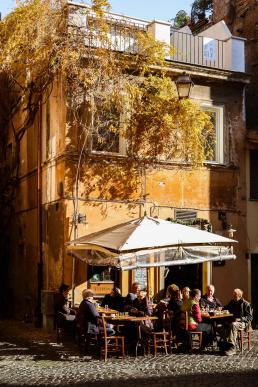
Italian cuisine, at its most basic, would have you questioning the very permutated versions you’ve probably eaten in your home country. Carbonara? It’s a simple mix of eggs and cheese – no cream unless you’re willing to risk your good standings. There is no such thing as Pepperoni pizza unless you have a taste for bell peppers, which what the word pepperoni actually means in Italian. There are many mutated assumptions developed outside Italy that a visit to the capital city could either undo the culinary damage or shock your system. Either way, there is a certain gastronomic joy in experiencing proper Italian flavours as intended.
There is a captured romanticism when it comes to Italy and food. Everywhere around Rome, one would spot a scene typical out of a postcard: a group of friends and family, seated outside a nondescript cafe or restaurant enjoying a meal and a few cups of coffee – the Roman sun strong above their heads. While the Italians are known to take importance in family and mealtimes, this is a tradition that exists outside the purview of plain sight. All around Rome in its public streets, it is typically tourists who partake in the afternoon espresso and stray plates of pasta – the menu prices usually too high for an average Italian to afford; what not when they could make something better in the secret confines of their own kitchen.
After all, there is nothing more sacred than an Italian mother’s cooking.
But in case you’re not as lucky, it pays to heed the fundamental Italian maxim: Mangia che ti passa. Eat and it will be over, you’ll feel better. The Italian word for recipe is ricetta, which derives from the Latin ‘recepta‘ meaning a medical prescription. In this sense, food is, aptly speaking for the Italians, food to heal the spirit, body and soul. I took this to heart with the many pasta variations I sampled, the espresso shots I gulped down, the gelatos I consumed and the pizza slices I devoured. And of course, not to forget the fried artichokes. Yes, those are compulsory.

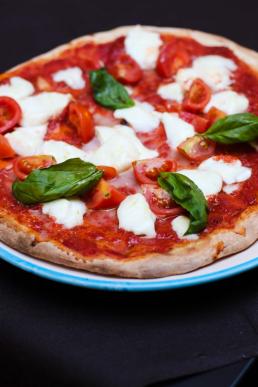
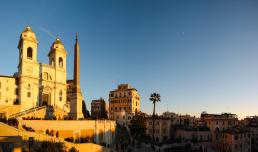
It is dusk, and the sun has dipped below the horizon, painting the bright sky in a pastel blue to amber. The customers seem either unimpressed or entirely captivated by the atmosphere. The former continuing their conversations and drink, the latter sharing the sunset in silence. The rooftop cafe was indeed another Roman experience where you paid a premium for the food and drink, in order to enjoy a view over the city’s arresting vista. And there is no better array of rooftop cafes than those located near the iconic Spanish Steps. The sunset over the entire architecture is an arresting sight indeed.

There is warmth to this ancient city and resilience to its people. Its streets transition seamlessly between asphalt and cobblestone, reflective of the porosity of this historical civilisation whose people and sense of being is continuously shifting. There is no clear distinction between where history ends, and modernity begins. Both superimposed upon each other like the colourful and rebellious graffiti that scar and force themselves upon these stone walls.

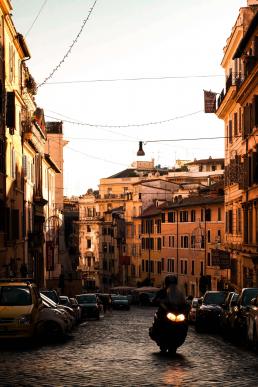
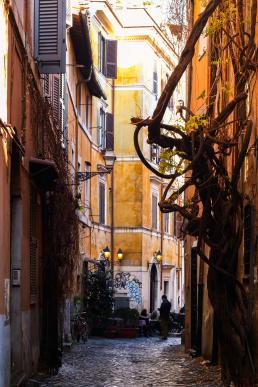

It is easy to lose oneself in Rome. With the preservation of its ancient facades and networked roads and alleys, it is impossible to return to the same place twice unless one possesses a map or a memory for landmarks. It is this porousness that also invites exploration; its many alleyways and palazzos that are a gate to everyday Roman life. One only needs to peek.
Recommended Reading:
- When it comes to ancient Rome, Hollywood sticks to the same old tired formula – The Conversation
- 36 Hours in Rome – The New York Times
- Rome’s sad decline sums up Italy’s problems – CNN
- ‘I love Rome, but Rome doesn’t love us’: the city’s new migrant crisis – The Guardian
- On the Hunt for Rome’s Disappearing Classic Dishes – Saveur
- Italian Cuisine: A Cultural History – Alberto Capatti and Massimo Montanari (Columbia University Press)